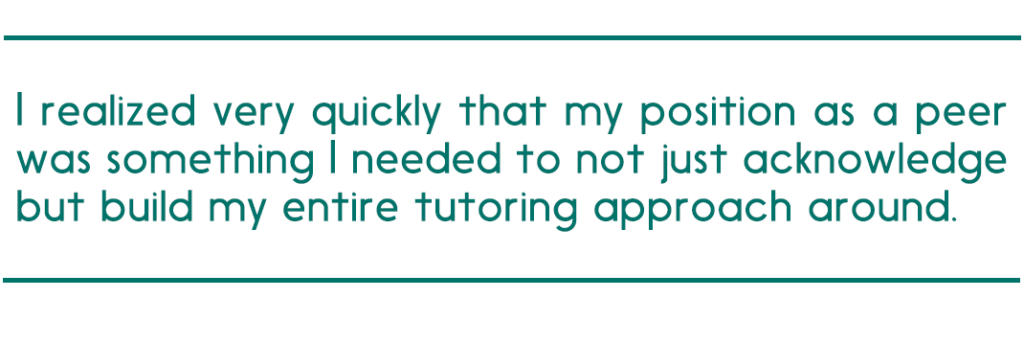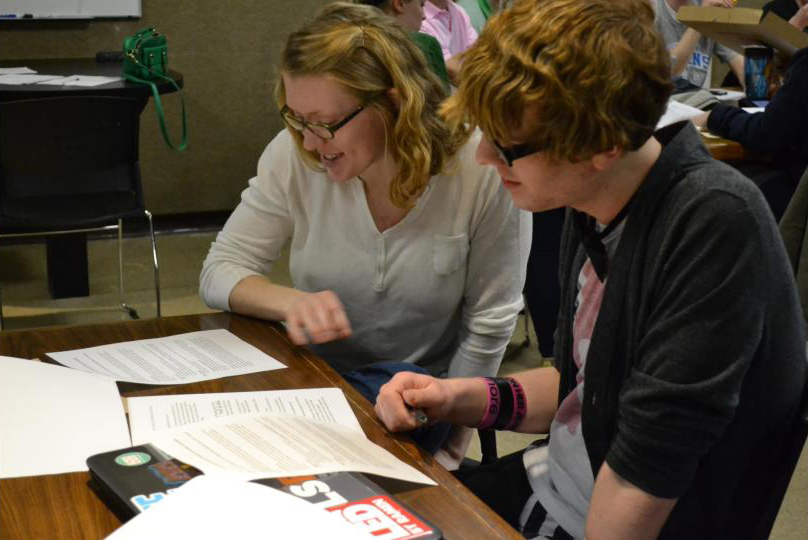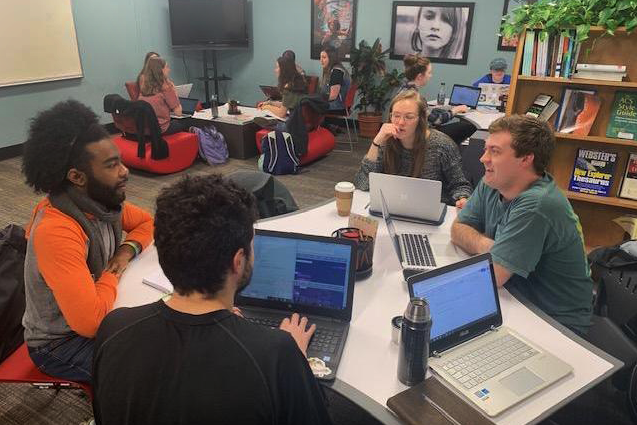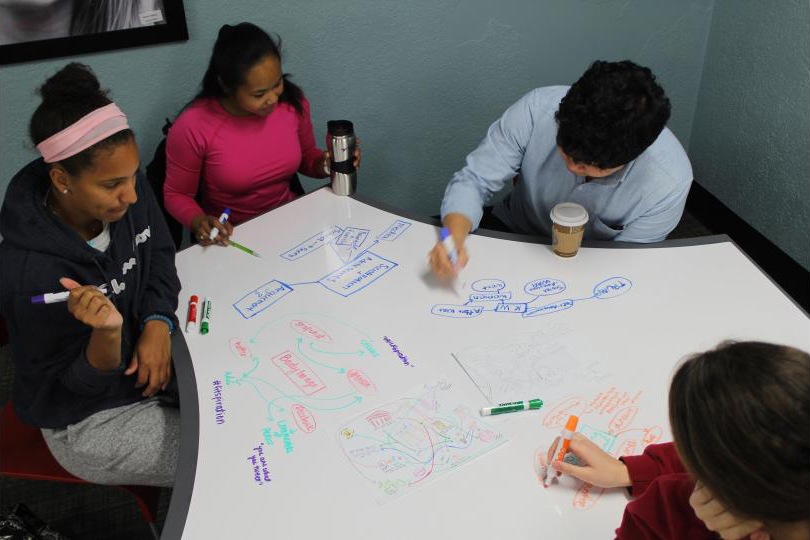By Ava Hutt, Kailie Settles, and Caroline Shutt, Transylvania University Writing Center
University writing centers offer a myriad of benefits for students. But like many useful academic resources outside of actual courses, it can be difficult to sell Transylvania University students on the idea of peer tutoring, especially given conflicts with time: clubs, athletics, off-campus jobs, and more. In an effort to combat this reluctance, and as a way to help assist students transition into college writing, Transylvania University Writing Center began implementing a Course-Embedded Peer Consultant initiative in 2014. Course-embedded consultants (known as “CECs”), like Writing Fellows or Writing Associates at other colleges, work with self-selected instructors to help enrolled students develop and revise 2-3 core assignments; students in these classes are required to meet with CECs at least twice per assignment (but often more, due to instructor design or student interest) to brainstorm topics, consider drafts, and/or develop revision strategies. Transy’s CEC program is currently paired with First-Year Seminar courses to help demystify writing center work and, more importantly, to assist students in the development of various rhetorical tactics. In 2018, our program earned the Martinson Award for Small Liberal Arts Writing Program Administration, due in part to our course-embedded work. In 2020-21, at the height of the pandemic, about half of Transylvania’s first year seminar offerings were supported by CECs.

As undergraduate writing center staffers who have also served as CECs, we’ve observed many benefits to such programming: student engagement, an emphasis on product revision, better campus optics, and more. However, despite such benefits, we also notice key impediments—including student hesitancy (perhaps heightened by the stresses of the pandemic), misconceptions of peer collaboration, and even, occasionally, lack of faculty buy-in. This blog post explores our experience with these concerns and emphasizes the need for clear expectations and roles in such an initiative. Clear expectations can help build and sustain the high degree of empathy that CECs need for such sustained, intentional work, given the extended collaborations with both students and faculty, and especially given the pressures of the current pandemic. Although we collectively recognize the value of our work as CECs and share much in common, in what follows we’ve listed our names at the beginning each section to showcase our particular experiences as staffers, collaborators, and peer learners.
Student Hesitancy
By Kailie Settles

Student skepticism, or difficulty getting a patron to “buy in” to the philosophy of the writing center, isn’t limited to CEC work. But when something is a requirement for a class, this can inspire feelings of boredom, hesitancy, discomfort, or in the worst-case scenario, resentment. While outright hostility from a patron is unlikely to be encountered as a staffer, in my experience, students are sometimes unengaged with the process. It’s important to note that this lack of engagement probably isn’t intentional. College students—especially new college students—have a lot to contend with, including jobs, financial struggles, academic stressors, mental health issues, or simply needing time to adjust to an entirely new chapter of life that might be thousands of miles from home. All of these challenges were amplified during the pandemic era.
But that doesn’t mean a lack of engagement is a done deal, and that it shouldn’t be challenged. Scott DeLoach argues in “Locating the Center: Exploring the Roles of In-Class Tutors in First-Year Composition Classrooms” that a course-embedded writing center staffer should serve as “a communicative bridge between the instructor and the student[s].” Most of the students I worked with, even if they weren’t necessarily invested in the academic process we were taking part in, were still keen to share with me frustrations, confusions, or general other comments they were not as comfortable expressing with their professor. None of it was inappropriate or disparaging, but often simply moments of students saying, “Hey, I’m not totally sure what the professor means by this.” I could then speak with the professor during check-in meetings and let them know some of the major concerns that students raised. I felt that I was able to be this “communicative bridge,” even if the things I was communicating to the professor dealt with student lack of interest.

Dealing with that lack of interest is an entirely different matter than simply conveying it to the professor, of course. It takes more than being a bridge to “sell” students on the writing center during their time in a course that participates in the CEC program. I realized very quickly that my position as a peer was something I needed to not just acknowledge but build my entire tutoring approach around. My experiences were in many ways theirs—and where we differed, I could still work to understand. It’s in this way that empathy becomes a crucial part of the staffer’s task at hand. My assigned first-year students and I were both facing a kind of disconnect with the transition from high school to college. Our feelings ranged from confusion and uncertainty to outright fatalism. Together, we suffered from what I often call “missing time” syndrome. As I worked with these students, I had to consider both our similarities and disparities, and how I could connect with these students rather than make them feel like passive participants. Writing for FYS classes, like all writing, does not happen in a vacuum; the challenges of our moment play into the work that students are asked to do, and our empathy as CECs can help students navigate such stresses.
The First Year Seminar course I was a consultant for focused on the cultural imagery of Dolly Parton. The essays dealt with Dolly from a range of perspectives: feminism, Appalachian identity, philanthropy, and more. One of the most interesting conversations I had with a student involved assessing Dolly through a distinctly queer lens. Talking with this student, even through the estrangement of a Zoom screen, I realized we were having a deeply cathartic and honest conversation about identity as two queer women borne out of a totally unexpected place. Maybe this conversation wasn’t directly tied to such things as paragraph organization, or the strength of rhetorical practices, or how to craft a perfect thesis statement. But if we expect our patrons to be invested in what we offer, we have to be more for them than an emotionless, counterclaim-reviewing machine. We have to be willing to be vulnerable to be writing center staffers, perhaps more so than we initially anticipated.
Misconceptions of Peer Collaboration
By Ava Hutt

Peer tutor vulnerability and empathy are crucial for CEC success, especially given the long-term nature of such collaboration. Because most students have never interacted with a writing center before coming to Transy, they usually don’t have any experience to draw on when imagining the kind of work that happens here. Or worse, they have prior experience with peer collaboration that shines a negative light on our work together. Titus et al. state in “Dialoguing A Successful Pedagogy for Embedded Tutors” that “the ET [Embedded Tutors] program seems to be what students [make] of it.” This much is true—ultimately, whether or not a student decides to participate is up to them, and the levels of participation will vary in any class. At the end of the day, student participation will always be influenced by their assumptions of what a writing center is. Students can’t help but form their own preconceptions about what peer collaboration in a writing center setting (in person or online) might look like. Because we as tutors don’t know exactly where students are coming from, we have to be willing to meet students where they are in terms of preconceptions. Upon first hearing about the Writing Center as a first-year student (and before becoming a staffer), I too felt reluctant to attend required visits. While none of the students I worked with voiced concerns of this kind with me, it seems unlikely that I’m the one they’d share them with.
Instead, I saw students show their misunderstanding of the purpose of their meetings with me, as a CEC, in more subtle ways. For example, one student I worked with showed up for all the required meetings, but left each meeting after as few as ten minutes of discussion despite the minimum meeting length of thirty minutes. Each time I prompted this student to stay, they insisted on leaving early. Although they never told me directly that they didn’t value talking through their ideas with me, they demonstrated that they felt this way by leaving early. Other ways that some, but certainly not all, students showed their lack of commitment to the collaborative efforts supported in CEC work included not following through on recommended revisions, or simply not engaging at all. To be sure, it is easier to recall more challenging sessions than successful ones, and many students seemed quite engaged in our work together; however, these particular sessions showed a continued need for clearer expectations shared across all stakeholders.

In their essay “Exporting Writing Center Pedagogy: Writing Fellows Programs as Ambassadors for the Writing Center,” Carol Severino and Megan Knight discuss student perception of the writing center in depth. In particular, they note that writing center outreach efforts “leave the majority of faculty and students with incomplete or even incorrect knowledge of basic writing center procedures.” At Transy, we use all kinds of promotional and framing efforts to help students better understand the value of collaborative pedagogy and specifically the value of long-term partnerships such as our CEC initiative.To be sure, we have evidence of success in such efforts; for example, a survey of students who participated in our Fall 2021 CEC program showed significant student buy-in: 55 out of 65 surveyed students noted that they would recommend CEC classes to peers. However, even with good intentions, certain key anecdotal experiences as noted above remind us that not all students clearly see the role of peer-to-peer writing pedagogy. Faculty engagement, as Caroline will discuss, also contributes significantly to student attitudes about our work.

Faculty Buy-In
By Caroline Shutt

Staffer training and vulnerability, as previously mentioned, are key to creating a successful writing center program for both peer tutor and student. But the third influential party in our sessions that we shouldn’t neglect to mention is the university faculty member. The presentation of the writing center made by professors, specifically in course-embedded tutoring partnerships, is a major component of creating shared expectations and an overall positive learning environment for both session contributors. Establishing not only the frequency of writing center engagement but also the attitudes one should carry into a session on behalf of the faculty can lay solid groundwork for staffers to build on.
In “Locating the Center,” DeLoach et al. describe a core principle in CEC work that we see play out in our sessions: aligning the expectations of staffers and professors is key to creating a successful program. In order for the writing center to create the collaborative environment we staffers believe in, we need the full support of the faculty we work with, and we need to know that we’re being backed up. First-year students are often skeptical about engaging with the writing center when they first come to college. DeLoach et al. explain that the in-class promotion of the writing center begins to change patron perspective without direct staffer involvement. Encouraging, even requiring, students to make appointments with the writing center as part of CEC classes improves relationships between “us” and “them.” The skepticism remains in place for the first few mandatory sessions, perhaps even increasing because of their requirement. But breaking through that barrier, with encouragement and shared language from the course professor, potentially creates an incredibly beneficial learning environment—connecting writing center practices to classroom needs.

DeLoach et al.’s work highlights the importance of faculty engagement and support but conversely acknowledges faculty challenges. Admittedly, faculty members are “keen participants in the process” of CEC work but “not entirely sure how much energy to invest in the process, or perhaps where to invest it.” Theoretically, they can be invested in the power of peer support in the writing process; putting theory into practice is harder. Weaving collaboration and consistent, sustained work with assigned CECs helps to create stability in both the staffer-professor and staffer-student relationship. In short, CEC work isn’t a condiment; rather, it’s core to the recipe.
We need professors to understand and emphasize the value of peer collaboration as a fundamental part of a writing-centered class; while they may not understand everything we do, our collaborations fundamentally improve the culture of writing on our campus. If we know that our partners are supportive in the classroom, then we can feel more confident working with their students because they, in turn, will feel less apprehensive about the inherent vulnerability of discussing writing. And even though many faculty members in this particular iteration of our program “bought in”—particularly because of a required, dean-supported, pre-semester workshop that allowed for faculty/staffer discussion of core CEC scholarship and space for semester planning—we still see faculty members who are either hesitant or checked out entirely. Although we recognize that the pandemic has affected faculty as well as students, this inadvertently harms the CEC program before the students even arrive.
To be sure, many programs like ours experience these and other challenges when it comes to creative collaborations between specific classroom spaces and writing center practices. Student hesitancy, misconceptions of peer collaboration, and lack of sustained faculty buy-in can thwart even the best of intentions. While it might seem simple, and perhaps even idealistic, clear communication from all parties involved in terms of roles, expectations, and benefits is a crucial component in building collective empathy and reaping the benefits of such an enterprise.
Works Cited
DeLoach, Scott, et al. “Locating the Center: Exploring the Roles of In-Class Tutors in First-Year Composition Classrooms.” Praxis: A Writing Center Journal. vol. 12, no. 1, 2014. [link]
Severino, Carol, and Megan Knight. “Exporting Writing Center Pedagogy: Writing Fellows Programs as Ambassadors for the Writing Center.” Marginal Words, Marginal Work? Tutoring the Academy in the Work of Writing Centers, edited by William J. Macauley and Nicholas Mauriello, Hampton, 2007, pp.19–34.
Titus, Megan, et al. “Dialoguing A Successful Pedagogy for Embedded Tutors.” Praxis: A Writing Center Journal, vol. 54, no. 1, 2014. [link]




